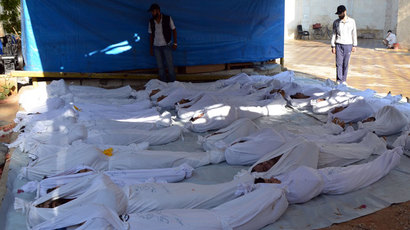US admiral says ships in Mediterranean ‘fully ready’ for potential Syria strike

US Navy destroyers in the Mediterranean are “fully ready” to launch cruise missiles into Syria as part of a US military campaign that would not involve “extraordinary” monetary costs, a top admiral said Thursday.
Admiral Jonathan Greenert said that the US was considering using Tomahawk missiles against Syria at a cost of $1.5mn each. His statement confirmed what no other officials had said publicly – though some had leaked similar information anonymously.
Greenert called the Tomahawks "a really good option" for commanders.
The Navy has four destroyers in the Mediterranean which are capable of launching cruise missiles into Syria. The US also has an aircraft carrier and accompanying warships in the Red Sea, should Washington decide to strike.
The US naval ships deployed in the region "are fully ready for a vast spectrum of operations, including operations that they may be asked to do, from launching Tomahawk missiles to protecting...the ships themselves," the admiral said.
Greenert, a chief naval operations officer who focuses on preparedness of Navy forces, also seemed to confirm the rough estimate made by US Defense Secretary Chuck Hagel on Wednesday in front of the House Foreign Affairs Committee, when he told Congress that a US campaign in Syria would likely cost "tens of millions" of dollars.
"The numbers are nagging but they're not extraordinary at this point," Greenert said at an event held by the conservative think-tank American Enterprise Institute.
Comments about the cost of intervention made by Hagel and Greenert reflect a belief that any US strike on Syria would be limited to a few days, though military budget analysts say Hagel’s figure is a low estimate.
"I was surprised when I heard him [Hagel] say tens of millions of dollars. That's low-balling it," Todd Harrison, a defense budget analyst at the Center for Strategic and Budgetary Assessments, told Reuters.
Much of the cost of a potential Syria strike would go to replacing munitions used. That funding would not be required until after September 30, when the 2013 fiscal year ends.
"If you include the replacement costs of munitions, [an operation against Syria] could cost half a billion, up to a billion dollars depending on the number of targets they go after," he said.
Should US military action in Syria extend beyond current estimates, a supplemental spending measure would have to be approved by Congress. Greenert did not rule out the need for a further spending authorization.
"A supplemental might be the order of the day," he said about a protracted involvement in Syria.
NATO fired 221 Tomahawk cruise missiles during its air war against Libya in 2011. Half of those were fired during the opening phase of the campaign. That intervention cost the US around $1bn in total, according to the Pentagon.














